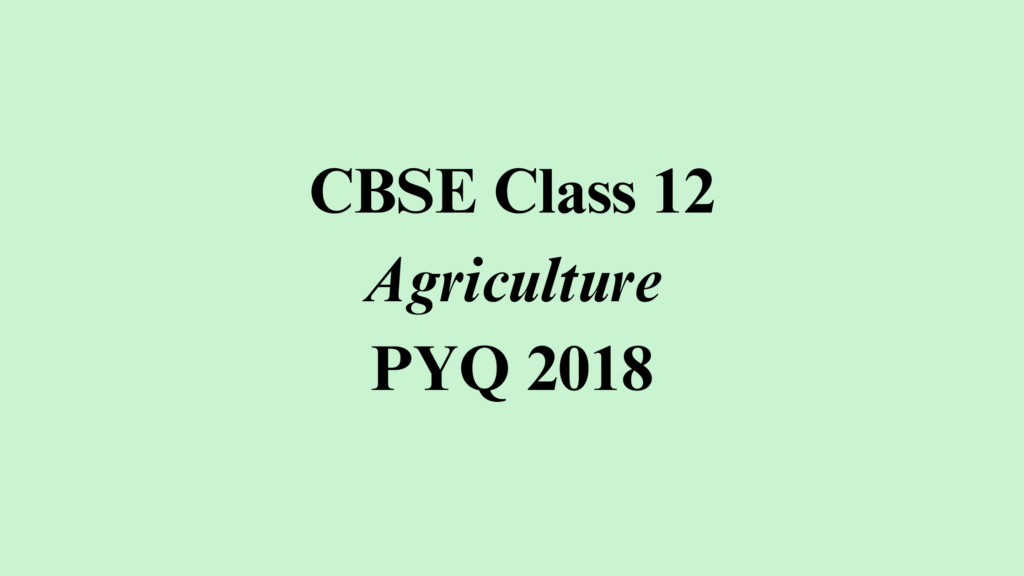Class 12 Agriculture PYQ 2018 Solved
Time Allowed: 3 hours
Maximum Marks: 70
1 Mark Questions
1. Name the factor on which the amount of sugar to be added in the preparation of fruit jelly depends.
Ans: Pectin
2. By what name is the seed of mushroom called?
Ans: Spawn
3. Name one important avenue tree.
Ans: Silver oak, Cassia, Gulmohar, Neem, Banyan, etc. (any one)
4. Give the reason for the appearance of whiptail disease in cauliflower.
Ans: Molybdenum deficiency
5. Mycorrhiza is an important biofertilizer used in agriculture for increasing the availability and absorption of which nutrient?
Ans: Phosphorus
6. Explain the role of dehydration in preservation of potato chips.
Ans: Available water is brought to a low level so as to check the growth of bacteria and moulds.
7. Which is the most suitable method of irrigation in the areas of water scarcity?
Ans: Drip irrigation
8. Name the fertilizer which can be used safely through foliar application.
Ans: Urea
9. Which is the most commonly used salt, as a source of SO2 (as preservative) in fruit preservation?
Ans: Potassium metabisulphIte (KMS)
2 Marks Questions
10. Discuss two important preserved flower products.
Ans: Preserved flower products
- Fragrance and flavours
- Dried flowers: Cock’s comb, Jasmine, Amaranthus, Areca and Coconut leaves and cut flowers come in this category.
- Dried flower parts: Dry stems and shoots are used
- Potpourri: It is a mixture of scented loose dry flowers kept in a polythene bag. Normally kept in cupboards, drawers, and bathrooms for fragrance.
OR
Discuss the importance of cut flowers.
Ans: Importance of cut flowers
- Used in indoor decoration as in flower vase.
- Preparation of Gajra, Garland, Veni, or Bouquets.
11. Choice of grass is an important part of lawn layout. List two most commonly used grasses in lawn making in India.
Ans: Any two
- Cynodon dactylon (Hariyali or Doob grass)
- Zoysia, (carpet grass or jumping grass )
- Paspalum grass
12. Analyse the procedure to get a nursery registration license.
Ans: Any person interested in establishing a fruit nursery in the particular area is advised to meet the SMS/ Horticulture Development Officer of that area and shall make an application in writing in the prescribed form and manner, accompanied by the revenue papers of the land and the prescribed license fee. At present, the license is valid for three years. After the validity period, the license can be renewed on the application of the owner with the renewal fee after inspection by the licensing authority.
13. Apprise the importance of soil pH to farmers.
Ans:
- The desirable pH range for optimum plant growth occurs at the optimum pH. While some crops grow best in the 6.0 to 7.0 range, others grow well under slightly acidic conditions
- Application of the right type of fertilizer can be recommended as some fertilizers are acidic, alkaline, or neutral in nature.
14. Write a note on packing of nursery plants in nurseries.
Ans: Packing of nursery plants –
Packing is the method or way in which the young plants are tied or kept together till they are transplanted. So, they have to be packed in such a way that they do not lose their turgidity and are able to establish themselves on the new site. At the same time, good packing ensures their success on transplanting. The baskets, wooden boxes, plastic bags, etc., are used for packing the plants with their earth ball. This is useful for local transportation.
3 Marks Questions
15. Write three criteria of essentiality of plant nutrients as proposed by Arnon.
Ans: The criteria for essentiality of a mineral element are given below:
- (a) The element must be necessary for supporting normal growth and reproduction. In the absence of the element, the plants do not complete their life cycle or set seeds.
- (b) The requirement of the element must be specific and not replaceable by another element. In other words, the deficiency of any one element cannot be met by supplying some other element.
- (c) The element must be directly involved in the metabolism of the plant.
16. Explain the following:
- Chlorosis
- Necrosis
- Dieback
Ans:
- (a) Chlorosis: It is a symptom of plant disease where the chlorophyll in green parts of the plant is lost due to a deficiency of mineral elements.
- (b) Necrosis: It is also a symptom of the plant where degeneration of the protoplast is followed by death of the tissue or organ, or the plant occurs due to a deficiency of nutrients.
- (c) Die back: Extensive necrosis of shoots from the top/ tip to downward.
17. Discuss the preservation of fruits by sugar.
Ans: Preservation by sugar:
Syrup containing 65% or more of sugar helps to check the growth of microorganisms and their multiplication.
Thus, sugar acts as a preservative by osmosis. Fruit syrup, jam, jelly, marmalade, preserves, candy, crystallized fruit, and glazed fruit are preserved by sugar.
18. Describe the various post-harvest operations in oil seed crops.
Ans: Various post-harvest operations in the oilseed crop
i) After the harvest, oilseeds are dried to reduce moisture content. Upon drying, the seeds are cleaned to remove foreign materials, including stones, metals, and dust from the seed, and later they are subjected to primary processing, where sorting, grading, packaging of seeds (in cloth or jute bags), and storage are done.
ii) For oil extraction processing following steps are followed
- The oilseeds are cleaned by passing high-speed air over them.
- They are dehusked, and the kernels are allowed to pass through the roller mills to rupture the seeds and increase the oil recovery efficiency.
- If required, the rolled flakes are cooked and heated to increase oil recovery.
- The oil is extracted by mechanical pressing, screw pressing, prepress solvent extraction and direct solvent extraction.
- The oil is filtered to remove any solid impurities. Later, it is refined to produce edible-grade oil.
- The byproduct, i.e., deoiled cake, is stored in bags for other commercial purposes.
19. List three roles or functions of the following mineral nutrients in plants:
- Calcium
- Magnesium
Ans: Role of calcium (Any three)
- Required by meristematic and differentiating tissues.
- Used in the synthesis of calcium pectate in the middle lamella.
- Required during the formation of the mitotic spindle.
- Involved in the normal functioning of the cell membrane.
- Important role in regulating metabolic activity.
Role of Magnesium (Any three)
- A constituent of the ring structure of chlorophyll
- Act as a cofactor for many enzymatic reactions of respiration, photosynthesis, and phosphate metabolism.
- Involved in the synthesis of DNA and RNA.
- Essential for the binding of ribosome subunits.
20. What is packaging? List the various packaging materials used in the food processing industry.
Ans: Packaging is the science, art, and technology of enclosing or protecting products for distribution, storage, sale, and use. Packaging also refers to the process of design, evaluation, and production of packages.
Materials Used As Food Packaging (Any four)
- Traditional or natural packaging materials are – Bamboo basket, fiber or leaf mats, Leather containers of animal skin, clay containers, gunny bags, and cloth bags.
- wooden boxes and crates
- Paper and board
- Glass
- Metal – tin, aluminum, Enameled containers, Containers made of Copper or Brass
- Ceramic Plastics
- biodegradable polymers
- Regenerated cellulose films
21. Differentiate between the following:
- Pasteurization and Preservation
- Class I Preservative and Class II Preservative
Ans: (a) Pasteurisation is a heat treatment that kills part but not all the microorganisms present and usually involves the application of temperatures below 100.
Preservatives are defined as “chemical agents, which serve to retard, hinder or mask undesirable change in food”.
(b) Class I preservatives include common salt, sugar, dextrose, glucose (syrup), wood smoke, spices, vinegar or acetic acid, honey, etc. They are used without limitation.
Class II preservatives include Inorganic substances like sulphurous acid, including salts thereof, nitrates of sodium or potassium, and organic substances like benzoic acid, sorbic acid. They are used in limitation.
OR
Differentiate between the following:
- Temporary and Permanent Preservation
- Syrup and Brine
Ans: (a) Temporary preservation: In this method growth of microorganisms is only retarded or inhibited for short time like low temperature preservation or with chemical preservatives.
Permanent preservation: In this method, the growth of spoilage microorganisms is completely destroyed by different means like drying, canning, freezing, etc., and prevented from further entry and growth of microbes by suitable packaging and storage.
(b) Syrup is are sugar solution of known concentration. Used in the canning or preservation of fruits.
Brine is a salt solution of known concentration. Used in the canning or preservation of vegetables.
5 Marks Questions
22. Fertilizers are used to enrich the soil with essential nutrients. Write the major nutrient supplied and percentage of nutrient present in the following fertilizers:
| Fertilizer | Name of the Nutrient | Percentage of Nutrient Present | |
| (a) | Urea | ||
| (b) | Anhydrous ammonia | ||
| (c) | Calcium cyanamide | ||
| (d) | Muriate of Potash (MOP) | ||
| (e) | Diammonium Phosphate (DAP) |
Ans:
| Fertilizer | Name of the Nutrient | % of Nutrient Present | |
| (a) | Urea | Nitrogen | 46% N |
| (b) | Anhydrous ammonia | Nitrogen | 82% N |
| (c) | Calcium cyanamide | Nitrogen | 21% N |
| (d) | Muriate of Potash (MOP) | Potassium | 60-62% K2O |
| (e) | Diammonium Phosphate (DAP) | Nitrogen and Phosphorus | 18% N and 46% P2O5 |
23. Describe the preparation of morabba (preserve).
Ans: Process of preparation of morabba:
Mature fruits→ Washing →Preparation of fruit for sugar treatment →Keeping fruit and sugar in alternate layers or steeping fruit in syrup of 40% TSS for a day → Removal of fruit → Increasing consistency of syrup to 60% TSS by boiling →Steeping of fruit for a day→ Repeating the process and raising strength of syrup by 5% TSS to 75% on alternate days → Preserve → Draining →Filling injars or containers → Sealing Storage.
OR
How can post-harvest management of fruits and vegetables increase their availability?
Ans: Post-harvest management of fruits and vegetables can increase their availability by
- Post-harvest losses are reduced at different stages. Thus, increases their availability.
- Processing of surplus fruits and vegetables into value-added products.
- Utilization of cull fruits and vegetables in processed products,
- Increase shelf life by improving post-harvest management.
- The quality of fruit and vegetables is maintained.
24. Enumerate the advantages and disadvantages of furrow method of irrigation.
Ans: Advantages of furrow irrigation
- Water in furrows contacts only one-half to one-fifth of the land surface.
- Labour requirement for land preparation and irrigation is reduced.
- Compared to check basins, there is less wastage of land.
Disadvantages of furrow irrigation
- The requirement for skilled labour is more
- The operation of machinery becomes difficult
- Drainage must be provided.
- Not suitable for all types of soil
25. (a) When did Indian Parliament pass the Food Safety and Standards Act?
(b) Mention one important function of the Food Safety and Standards Authority of India (FSSAI).
(c) Write a short note on AGMARK.
Ans: (a) 2006
(b) Any one function
- Framing of Regulations to lay down the Standards and guidelines in relation to articles of food and specifying an appropriate system of enforcing various standards
OR
- Laying down mechanisms and guidelines for accreditation of certification bodies engaged in the certification of food safety management systems for food businesses.
OR
- Laying down procedure and guidelines for accreditation of laboratories and notification of the accredited laboratories.
OR
- To provide scientific advice and technical support to the Central Government and State Governments in matters of framing the policy and rules in areas that have a direct or indirect bearing on food safety and nutrition
(c) AGMARK is a Quality Certification Mark. It ensures the quality and purity of a product. Quality standards for agricultural commodities are framed based on their intrinsic quality. Products available under AGMARK are as follows:
- i. Pulses
- ii. Whole spices & ground spices
- iii. Vegetable oils
- iv. Wheat Products
- v. Milk products
OR
- When was the Food Safety and Standards Authority of India (FSSAI) established?
- What is the objective behind food laws?
- Write in brief about Fruit Product Order (FPO).
Ans:
(a) 2006
(b) Any one
- To meet a country’s sanitary and phytosanitary requirements, food must comply with the local laws and regulations to gain market access.
- These laws ensure the safety and suitability of food for consumers.
(c) Fruit Product Order (FPO), 1955
The main objective is to lay down quality standards to manufacture fruit & vegetable products, maintaining sanitary and hygienic conditions in the premises. It is mandatory for all manufacturers of fruit and vegetables to obtain a license under this Order.
26. (a) What is thermal processing?
(b) Explain the various methods of thermal processing.
Ans: Thermal processing: Application of heat helps preserve food by inactivating the enzymes, destroying the microorganisms. If it is appropriately packaged to prevent recontamination, the food can be stored for extended periods of time. The heat treatment achieved during the cooking of foods also helps to render the food safer and palatable.
Thermal processing can be done by following these methods:
- Blanching: The primary purpose of blanching is to destroy enzyme activity in fruit and vegetables. It is not intended as a sole method of preservation, but as a pre-treatment prior to freezing, drying, and canning. Other functions of blanching include: Reducing surface microbial contamination, softening vegetable tissues to facilitate lining into containers, and removing air from intercellular spaces prior to canning. These conventional processes are simple and inexpensive.
- Pasteurization: It is a heat treatment that kills part but not all the microorganisms present and usually involves the application of temperatures below 100. The heating may be by means of steam, hot water, dry heat, or electric currents, and the products are cooled promptly after the heat treatment.
- Sterilization: It is a method of destruction of all microorganisms using temperatures above 100°C. Sterilization is generally carried out at temperatures ranging from 116°to 129°C.
27. What is organic farming? Explain the various components of organic farming.
Ans: Definition of the USDA “organic farming is a system which avoids or largely excludes the use of synthetic inputs (such as fertilizers, pesticides, hormones, feed additives etc.) and to the maximum extent feasible rely upon crop rotations, crop residues, animal manures, off-farm organic waste, mineral grade rock additives and biological system of nutrient mobilization and plant protection”. or definition
OR
FAO suggested that “Organic agriculture is a unique production management system which promotes and enhances agro-ecosystem health, including biodiversity, biological cycles and soil biological activity, and this is accomplished by using on-farm agronomic, biological and mechanical methods in exclusion of all synthetic off-farm inputs”.
Components of Organic Farming
- Crop rotation
- Crop Residue
- Organic manure
- Bulky organic manure
- FYM
- Compost
- Green Manuring
- Concentrated Organic Manure
- Bulky organic manure
- Waste
- Industrial waste
- Municipal and Sewage waste
- Biofertilizers
- Bio-pesticide
- Vermicompost
OR
Describe the various advantages of using biofertilizers in agriculture.
Ans: Advantages of biofertilizer (Any five)
- 1) Fixes atmospheric nitrogen.
- 2) Increase availability or uptake of nutrients through solubilization or increased absorption.
- 3) Stimulate plant growth through hormonal or antibiotic action or by decomposing waste.
- 4) They are cheap, hence, reduced cost of cultivation.
- 5) Improves soil properties and sustains soil fertility.
- 6) Lead to soil enrichment.
- 7) Build up soil fertility in the long term.
- 8) Curtails the requirement of inputs.
- 9) They are eco-friendly.
Additional Practice Papers
- Class 12 Agriculture Syllabus 2025-26
- Class 12 Agriculture PYQ 2024
- Class 12 Agriculture PYQ 2023
- Class 12 Agriculture PYQ 2022
- Class 12 Agriculture PYQ 2020




